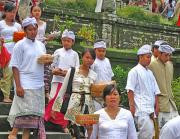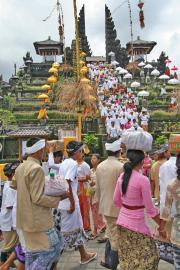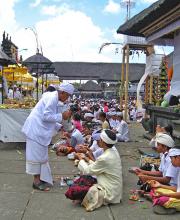Gunung (or Mount) Agung is an active volcano which soars 3142 metres (10,400 ft) into the sky. When staying in Kuta and the lowlands it is often forgotten that the island is mountainous. Gunung Agung is Bali's holiest mountain and the seat of the gods.
|
Gunung Agung often shrouded in mists is Bali's most sacred spot. High on its slopes sit Pura Besakih or Besakih Temple. It is the largest temple of the island and large numbers of devotees from all over Bali attend temple ceremonies at certain times of the year.
The gods rest above Gunung Agung's summit and watch over the island. They sometimes descend to Pura Besakih to attend temple festivals. The Gods visit the temple on the days the Balinese hold festivals to honour the gods, or are the festivals held to placate the gods?
The Balinese believe that their island belongs to the gods and that they are custodians to look after its well being. Their religion is a mix of animist beliefs coloured by Hindu traditions and deities. Sanghyan Widi Wasa is their supreme god. Deities are ever present in the lives of the Balinese. Good spirits guard over mountains and temples. Evil ghosts lurk along deserted beaches and in night shadows.
Mount Agung is both a source of life and death. From it flow the streams that water the paddy fields. The fertile volcanic soil nourishes the land. But from the same mountain comes destructive lava, fire and ash as its latest eruption in 1963 proved only too well. That day the gods must have been disgruntled because the eruption occurred during a purification ceremony held once every Balinese century. (A Balinese year has 210 days)
Ironically, this ceremony was conducted to restore the harmony between the forces of nature and man. The lava flow stopped just before it reached the temple. The gods spared Besakih. No wonder that the Balinese run their legs off to propitiate the gods. Offerings help.
|
|
| Favourite spots: |
 |
 |
 |
 |
 |
 |
 |
 |
peaked headgear and collared shirts
 |
 |
When we visited Besakih we were in luck because an important ceremony was in full swing. It was the day, or rather the days that 'the gods descend to earth', Bhatur Turun Kabeh. A hustle and bustle of people, all dressed in ceremonial garb buzzed about the temple grounds. The women wore lacey, close-fitting long-sleeved blouses, tightly wound sarongs and sashes around their waist. The men were in white collared shirts and wore hip clothes over their sarongs.
A trip to Besakih is not only a day of offering but also a festive day out. Vendors had set out their stalls laden with edibles and durables. Peddlers paraded through the crowd with soft drinks in ice boxes. Women devotees zigzagged through the crowd carrying flower-and fruit offerings on their heads.
|
|
| What's really great: |
Pura Besakih is not just one pura but a complex of 22 temples scattered over Mount Agung's southern slope. Like all Balinese temples they are not closed buildings but open-air affairs. Each temple is made up of a courtyard filled with altars and shrines devoted to a number of gods.
Our guide pointed at the kitchen area and said: "This is where the priest are frying." Indonesians have difficulty in pronouncing English and in distinguishing between the letters P and F. What he meant was 'praying'.
He also pointed at the meru, multi-tiered roofs of Balinese shrines. Three-levelled ones are used to store temple treasures, eleven tiers to honour Sanghyang Widi, Bali's supreme god. He then showed us an open pavilion which is especially built for the gods, where they can gather and watch the colourful ceremonies.
|
|
| Sights: |
 |
 |
 |
 |
 |
 |
 |
 |
They entered the temple through a split gate
 |
 |
The devotees walked up stone stairs and entered the temple through a candi bentar, a split gate guarded on both sides by statues of temple guards. As far as I know, this architectural feature is unique to Bali. It looks like a tower that has been sliced into two. Legend has it that the two sides represent mythical mount Meru, which Siwa split into two resulting in Gunung Agung and Gunung Batu, the two highest mountains of Bali.
The temple is out of bounds for non-hindus. Therefore, we simply watched procession of women, men and children ascend the stairs and enter the temple. They smiled and did not mind my taking their pictures.
|
|
| Accommodations: |
 |
 |
 |
 |
 |
 |
 |
 |
the flicker of holy water
 |
 |
Prayer for the Balinese is very much part of every day life just like breathing, eating and bathing. The scent of incense, the tinkle of the temple bells, orderly rows of people heads bowed waiting for the flicker of holy water from the priest are impressions that I will never forget.
Another typical scene are the women and girls engaged in weaving dozens of kinds of offerings. Little ornaments resembling pinwheels, flutted bamboo rosettes and nosegays of tasselled palm leaves. They are stuck to the edges of the thatched roofs of the little shrines, they dangle from large bamboo polls and balance on the bonnet of cars.They are little prayers and a tangible evidence of the Balinese desire for spiritual communication.
|
|
| Nightlife: |
HOW TO GET TO BESAKIH
All tourist resorts have agents who offer organised tours. See to it that they give at least one hour to visit Besakih and longer when there are ceremonies.
It is also possible to get to Besakih under your own steam. There are bemos (mini buses) from Klungklung to Besakih with a change at either Rendang or Menanga.
Green bemos run from Amlapura via Selat and Menanga. There are lots of them in the morning but very few in the afternoon.
There are no bemos to Penelokan on lake Batur and no Bemos from Rendang to Bangli.
|
|
| Hangouts: |
We visited Besakih from Amed in east Bali and hired a car and driver (Rp 450,000 = € 40 in 2007). This meant that we could also include a visit to Lake Batur and Pura Ulun Danau Batur, the second holiest temple in Bali.
Entrance fee to Besakih is Rp 100,000 (€ 8.50 in 2007) per person. It is normal practice to negotiate over the price. We haggled down to RP 60.000 (€ 5) which included sarongs for 6 people and a guide.
In all temples sarongs and often sashes are obligatory. If you like you can bring your own.
|
|
| Restaurants: |
There are two kind of guides; the official ones with geometrical patterned shirts and sarongs as uniform and the numerous self-appointed guides.
An official one is appointed to you when you pay your entrance fee. If you decide to visit without a guide, the unofficial ones will approach you during your visit. Should you decide to engage one, establish their fee beforehand as it saves a lot of arguments at the end of your tour as they ask astronomical prices. Rp 20.000 – 30.000 (€ 1.70 – 2.50) is a reasonable amount. (in 2007)
If the guide leads you to a priest inside a temple for a blessing you are expected to make an obligatory donation. Your guide will negotiate the amount. You have no choice.
|
|
| Other recommendations: |
Besakih is a straightforward affair and no guide is needed because guidebooks such as Lonely Planet and the Rough Guides give comprehensive information about the temple lay-out, more than the guide provides. If you are lucky he speaks good English, but often he doesn't.
However, it is a good thing to engage a guide, even if he doesn't add much to your understanding of the temple and the ceremonies. Tourists numbers are declining and guides need an income. See your contribution as a personal donation to help someone in the third world.
|
|
Published on Friday May 25th, 2007
|
|
 Publish on Facebook
Publish on Facebook
|
Wed, Jun 13 2007 - 11:29 AM
 by delfster
hi there marriane...
back in indonesia again. love to read your report.
plenty of details... and great information
i hope to read more of your travel soon.
i myself just got back from my holiday in Bali. But I went to Ubud and just around Benoa shore. But haven't got the drive yet to write the report. So, hope you have great time around.
cheers,
Delvi |
Wed, May 30 2007 - 01:57 AM
 by akhila by akhila
Marianne, makes me want to get there right now :-) seems like you had a wonderful time.
Best regards, |
Mon, May 28 2007 - 11:01 PM
 by downundergal by downundergal
A great report for someone to learn about the Balinese culture and Hindu beliefs, nice candid shots too!
This bought back memories of a fantastic site and of the welcoming and gentleness of the Balinese.
I really liked it. |
Mon, May 28 2007 - 02:18 AM
 by frenchfrog by frenchfrog
| A very inspiring and very detailed report, well done. Pictures are great as well! |
Sun, May 27 2007 - 09:44 AM
 by mistybleu by mistybleu
| A wonderful insight into life in Indonesia, with some great illustrations. |
Sat, May 26 2007 - 03:05 PM
 by eirekay by eirekay
| Marianne, the photos in this report are what make it so moving. You have capture their devotion in a very beautiful way. Nicely done! |
Fri, May 25 2007 - 10:39 PM
 by rangutan by rangutan
| Another well written, colourful and interesting report. I would prefere more info and use of the standard GLOBO structure for a report yet love this detailed aspect of a place too. Would a slideshow with detailed comments not be more effective? Or ALL the headings optional and just a total limit of characters set at 10000? |
| Information: |
| Login if you are a member, or sign up for a free membership to rate this report and to earn globo points! |
|
| Brunei |
|
|
 |
| Czech Republic |
|
|
|
|
|
|
|
|
|
|
 |
| Estonia |
|
|
 |
| Germany |
|
|
 |
| Greece |
|
|
 |
| Hungary |
|
|
 |
| India |
|
|
|
|
|
|
|
|
|
|
|

|
